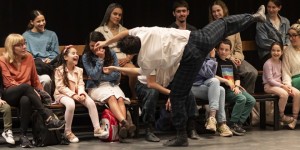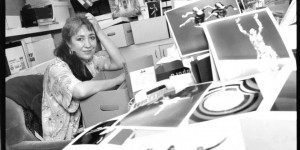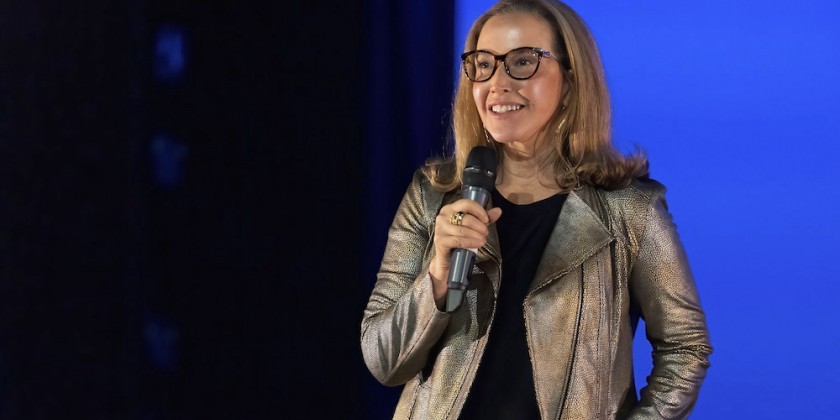Ina Hahn's Documentary on Doris Humphrey Premieres at The 2011 Dance On Camera Festival in New York City

Now, in her eighth decade, the irrepressible dancer Ina Hahn adds yet another title to her long list of accomplishments--Documentarian. Her film A Dance for America: The Choreography, Teachings, and Legacy of Doris Humphrey has been selected to premiere at 2011 Season of The Dance On Camera Festival in New York City.
Ina Hahn’s film, A New Dance for America-The Choreography, Teachings and Legacy of Doris Humphrey, premieres at the 2011 Dance On Camera Festival in NYC
©Christine Jowers 2011
Showings are: Friday January 28th at 1:30 pm and Tuesday February 1 at 6pm at The Walter Reade Theatre
For information and Tickets for The Dance On Camera Festiva 2011Click here...
When Hahn and I spoke via phone about her film
she said that she had just been chatting with
Patricia Ward Kelly (Gene Kelly’s widow)
who wanted to share that Gene thought Doris Humphrey’s book
The Art of Making Dances
was the best book on choreography ever written
and
a major influence
on his work.
Ina Hahn has been both a modern concert dancer and a Broadway hoofer sharing stages with the notable American pioneers: Doris Humphrey, Charles Weidman, José Limón,Helen Tamiris, Jerome Robbins and Michael Kidd. She has been a choreographer, a teacher, a labanotator, and a reconstructor of Doris Humphrey works. As a member of Humphrey’s Dance Company, she danced in “New Dance,Variations and Conclusions” and “Passacaglia."
Jerome Robbins requested she join the cast of “The King and I” on Broadway, where she was also Gwen Verdon’s understudy, and The Inchworm, in Michael Kidd’s “Can,Can.” (By the way, NO, she has never seen those movies. It is difficult for her to see the movies of Broadway shows she’s performed in.)
Currently, Hahn is the Executive Director of the Windhover Center for the Performing Arts in Rockport, Massachusetts--a highly regarded home for the arts that she and her husband Herbert built up from a small farm they purchased in 1967. For over 40 years she has been teaching dance and choreography there as well as at colleges throughout the Northeast, including Smith, Hampshire, Radcliffe, Harvard, Boston Conservatory, and M.I.T. Now, in her eighth decade, this irrepressible dancer adds yet another title to her long list of accomplishments--Documentarian. Her film A Dance for America: The Choreography, Teachings, and Legacy of Doris Humphrey has been selected to premiere at the 2011 Season of The Dance On Camera Festival in New York City at The Walter Reade Theatre. Recently when Hahn and I spoke via phone about her film, she said that she had just been chatting with Patricia Ward Kelly ,Gene Kelly’s widow, who wanted to share that Gene thought Doris Humphrey’s book, The Art of Making Dances was the best book on choreography ever written, and a major influence on his work. I could feel Hahn's thrill at this over the wires.
“After years, I decided to just DO it.”
Hahn describes her neighbors in Rockport, MA as very intelligent, culturally aware folks. So, why was it ,she wondered, when they would enter into conversation with her about her beloved field-- modern dance-- the first and often only name to come up would be Martha Graham’s? This was extremely frustrating to Hahn who studied with both legendary women. She was spurred to remind the world about Humphrey. “After years, I decided to just do it.” At first it was going to be a film about Martha Graham and Doris Humphrey, but, “I so obviously loved Doris, I thought that would be unfair."
“It was refreshing and eye-opening to have dance expressed,
not as something that is thrown together,
but as an art with form and structure, as important and rigorous
as literature
and music."
“Eye -Opening”
In the 1950’s, Hahn, an English major at Wellesley College, would travel to Boston on weekends to study dance “in the living room of a couple of sisters on Commonwealth Avenue”. Fortuitously the sisters happened to be offering teaching space to José Limón. Hahn immediately connected to the acrobatic element in Limón’s work, "It felt very natural." Limón encouraged her to attend The American Dance Festival at Connecticut College to study with Doris Humphrey, so she did.
Hahn learned Humphrey’s “Passacaglia in C Minor” in repertory class and remembers distinctly how much she loved the music and Humphrey’s approach to it. Using nine count phrases and working against the musical structure provided by Bach instead of directly following it appealed to her intellect, as well as to her love of music and movement. “Doris was so clear verbally,” (by this time she couldn’t dance-due to an arthritic hip-and had to use a demonstrator) "and she was at once demanding and encouraging. She was not ego- based. She was extremely supportive of her students work and would attend our concerts and give critiques."
After the Connecticut College experience, Hahn was offered an opportunity to teach at Radcliffe. After a year, she left in order to take Humphrey's composition class at the 92nd Street Y in New York City on a scholarship Humphrey personally arranged.
“It was refreshing and eye-opening to have dance expressed, not as something that is thrown together, but as an art with form and structure as important and rigorous as literature and music.” That was something a Wellesley girl could deeply appreciate.
The Film- “I swear Doris choreographed it.”
Hahn spent much of the 1990’s in The Jerome Robbins' Dance Division of the Lincoln Center Library combing through Humphrey’s works. In 2006, she held a Doris Humphrey Symposium at Windhover replete with technique and repertory classes, lectures, and performances conducted by Humphrey experts who were eager to reunite and share,(excerpts from the symposium will be shown in the documentary). Among the participants were Lucy Venable, Hahn’s former classmate at the 92nd St. Y, also a highly regarded Limón teacher and dance notator; Stephanie Clemens, important re-creator of Humphrey works in Chicago; Gail Corbin ,protégé of Ernestine Stodelle who was considered to be the foremost authority on Humphrey's choreography and technique; Marcia Siegel, noted dance critic and author, and Charles Woodford, Doris Humphrey’s son. “It was amazing, a miracle, and stimulating to see so many different takes (on Humphrey)," Hahn reminisces, “I swear Doris choreographed it.”
Challenges, Gifts, and Perhaps Martha Graham did have something to do with this?
The largest challenge in creating the documentary was financial. Assembling a group that could help her affordably produce was key. Hahn describes her collaborators as gifts: producer, Phil Hopkins, the founder of dogtown productions, Inc; actress Lindsay Crouse, the voice of Doris Humphrey in the film , and Hahn’s student at Radcliffe; and her technical advisor, Richard Winik. Winik, a sports photographer, whose eye proved invaluable to the process, encouraged Hahn to cut even some material she adored -(the sign of a good editor). In the 80's Winik was requested by Martha Graham to film some of her dances, because, as she told him, "She wanted someone who knew where the action was."













